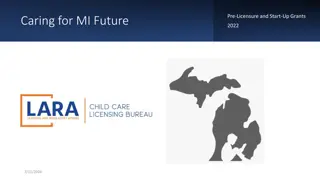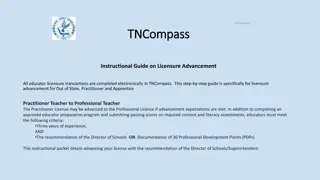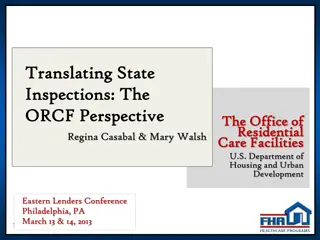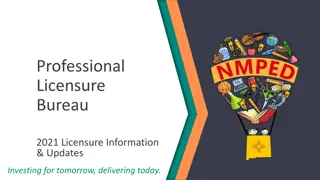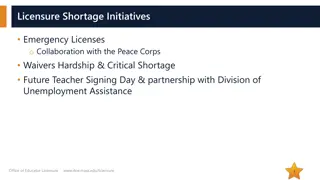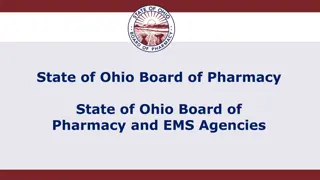Rethinking Teacher Licensure Policies: Challenges and Opportunities
This article discusses the importance of reevaluating current teacher licensure policies to engage and retain educators. It highlights the overlooked requirements and options for ongoing teachers, focusing on challenges and opportunities in license renewal, advancement, and professional growth opportunities. The piece emphasizes the significance of meaningful teacher development for retention and highlights the varying state requirements for attaining advanced roles in the education sector.
Download Presentation

Please find below an Image/Link to download the presentation.
The content on the website is provided AS IS for your information and personal use only. It may not be sold, licensed, or shared on other websites without obtaining consent from the author.If you encounter any issues during the download, it is possible that the publisher has removed the file from their server.
You are allowed to download the files provided on this website for personal or commercial use, subject to the condition that they are used lawfully. All files are the property of their respective owners.
The content on the website is provided AS IS for your information and personal use only. It may not be sold, licensed, or shared on other websites without obtaining consent from the author.
E N D
Presentation Transcript
Food for Thought Data Slides
Population per Region (in millions) Distribution for class of 25 students Northern America = 368 (4%) Europe = 747 (10%) Asia = 4,626 (59%) Latin America = 651 (8%) Africa = 1,338 (17%)
Population Demographic Terms Population: Number of people living in a region. Birth Rate: Number of births per 1,000 people per year. Death Rate: Number of deaths per 1,000 people per year. Rate of Natural Increase: Growth caused by having more births than deaths in a year (does not include immigration or emigration). Doubling Time: Number of years it will take a population to double in size if it maintains its current growth rate.
Population Demographics Food for Thought Northern America Latin America Europe Africa Asia Population (in millions 2020) 368 651 747 1,338 4,626 Birth Rate (per 1,000) 11 16 10 34 17 Death Rate (per 1,000) 8 6 11 8 7 Growth Rate (natural increase) 0.3% 1% -0.1% 2.6% 1% Doubling Time (in years) 231 70 - 27 70
Quality of Life Terms Literacy Rate: Ability of an individual to read and write, with understanding, a simple short statement related to his/her everyday life. Total Fertility Rate: Average number of children a woman will have in her lifetime. Infant Mortality Rate: Yearly number of children who die before reaching the age of one year per 1,000 live births. Life Expectancy: Average number of years a person born today could expect to live. Access to Improved Sanitation: Percentage of population with access to improved sanitation facilities that hygienically separate sewage from human contact. Nurses and Midwives:Total number of people for every one nurse or midwife by region.
Quality of Life Indicators Food for Thought Northern America 96%; 96% 94%; 93% 99%; 99% 74%; 60% Latin America Europe Africa Asia Adult Literacy Rate (men; women) Fertility Rate 90%; 81% 1.7 2 1.5 4.4 2 Infant Mortality Rate (per 1,000) Life Expectancy 6 14 4 49 27 79 76 79 64 73 Access to Adequate Sanitation (urban; rural) 1 Midwife or Nurse per # of People 100%; 100% 72 91%; 70% 98%; 96% 52%; 32% 84%; 67% 201 114 899 394
Land Use Terms Urban Population: Percentage of the total population living in areas termed urban by that country (typically towns of 2,000 or more or in national or provincial capitals). Arable Land: Farmland; land capable of growing crops. Here it is expressed in terms of acres of land per person. An acre is about the size of a U.S. football field.
Land Use Patterns Food for Thought Northern America 82% Latin America 79% Europe Africa Asia Urban Population 75% 43% 51% Arable Land (acres/person) 1.3 0.6 0.9 0.4 0.3
Urban to Rural Ratio & Arable Land per Person Europe Northern America Asia 18% Rural 25% Rural 49% Rural 51% Urban 75% Urban 82% Urban 1.3 acres/person 1.3 acres/person 0.9 acres/person 0.9 acres/person 0 0.3 acres/person .3 acres/person Africa Latin America 21% Rural 43% Urban 57% Rural 79% Urban 0.4 acres/person 0.4 acres/person 0.6 acres/person 0.6 acres/person
Energy Consumption and Wealth Terms Energy Consumption: Total amount of energy used by each region per year divided by the number of people living in that region (includes industrial use). Access to electricity refers to the percentage of the population who have electricity in their homes. Gross National Income (GNI): : A measure of a nation s wealth, GNI is the total domestic and foreign output claimed by residents of a country. Here it is expressed per capita (dividing the total GNI by the region s population) and Purchasing Power Parity (PPP) taking into account the different price levels and costs of living.
Energy Use and Wealth Food for Thought Europe Africa Asia Northern America 53 barrels; 100% Latin America 10 barrels; 98% Per Capita Energy Consumption (barrels of oil equivalent; % Access to Electricity Per Capita GNI (PPP) in US$ 26 barrels; 100% 3 barrels; 56% 11 barrels; 95% $62,327 $15,944 $38,709 $4,820 $12,810
Per Capita Energy Consumption (barrels of oil equivalent) 1 match = 1 barrel of oil Northern America Latin America Asia Europe Africa 3 barrels 10 barrels 11 barrels 26 barrels 53 barrels
Per Capita GNI 1 candy = $1,000 USD Northern America Latin America Europe Africa Asia 5 candies 13 candies 16 candies 39 candies 62 candies




